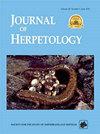Diamondback Terrapin (Malaclemys terrapin terrapin) Density and Space Use in Dynamic Tidal Systems: Novel Insights from Spatial Capture–Recapture
IF 0.8
4区 生物学
Q3 ZOOLOGY
引用次数: 0
Abstract
Abstract. The status, size, and density of Malaclemys terrapin (Diamondback Terrapin) populations along the Atlantic coast have been reported by most states as unknown or declining. Robust demographic or population data are lacking, with even less information available on their spatial ecology. Spatial capture–recapture (SCR) methods explicitly incorporate spatial processes, providing a formal link between encounter data and space use. Despite the widespread adoption of SCR across ecological disciplines, it has yet to be applied to turtle populations. We present the first application of SCR methods to Diamondback Terrapins by analyzing data collected from two known activity areas in the tidal marsh systems of Wellfleet Bay, Massachusetts. We found that Terrapin detection was positively associated with survey effort at both sites. Detection was also influenced by day of season, tide cycle, the time of tide, survey time relative to the tide, cloud cover, and windspeed. Density and space use differed markedly between the two sites: the estimated density in The Run was 9 individuals/ha with a space use parameter of 309 m, compared to 59 individuals/ha and a space use parameter of 107 m in The Cove. Sex structure was female-biased, with a sex ratio of 0.34 and 0.18 males in The Run and The Cove, respectively. We demonstrate the utility in using SCR methods in turtles, specifically Diamondback Terrapins, to produce comparable estimates of detection and population size and density, while simultaneously providing inference on differential space-use and detection resulting from variation in both behavior and sampling conditions.动态潮汐系统中的响尾蛇Terrapin(Malalemys Terrapin Terrapin)密度和空间利用:空间捕获-再捕获的新见解
摘要据大多数州报告,大西洋沿岸马六甲水龟(响尾蛇水龟)种群的状况、大小和密度未知或正在下降。缺乏可靠的人口统计或人口数据,关于其空间生态的信息更少。空间捕获-再捕获(SCR)方法明确地结合了空间过程,在相遇数据和空间使用之间提供了正式的联系。尽管SCR在生态学科中被广泛采用,但它尚未应用于海龟种群。我们通过分析从马萨诸塞州韦尔弗利特湾潮汐沼泽系统的两个已知活动区收集的数据,首次将SCR方法应用于响尾蛇Terrapins。我们发现Terrapin的检测与两个地点的调查工作呈正相关。探测还受到季节、潮汐周期、潮汐时间、相对于潮汐的调查时间、云量和风速的影响。两个地点的密度和空间利用差异显著:the Run的估计密度为9人/公顷,空间利用参数为309米,而the Cove的估计密度和空间使用参数分别为59人/公顷和107米。性别结构偏向女性,The Run和The Cove的性别比分别为0.34和0.18。我们证明了在海龟,特别是响尾蛇Terrapins中使用SCR方法的实用性,以产生对检测、种群规模和密度的可比估计,同时提供对行为和采样条件变化导致的差异空间使用和检测的推断。
本文章由计算机程序翻译,如有差异,请以英文原文为准。
求助全文
约1分钟内获得全文
求助全文
来源期刊

Journal of Herpetology
生物-动物学
CiteScore
1.60
自引率
0.00%
发文量
45
审稿时长
6 months
期刊介绍:
The Journal of Herpetology accepts manuscripts on all aspects on the biology of amphibians and reptiles including their behavior, conservation, ecology, morphology, physiology, and systematics, as well as herpetological education. We encourage authors to submit manuscripts that are data-driven and rigorous tests of hypotheses, or provide thorough descriptions of novel taxa (living or fossil). Topics may address theoretical issues in a thoughtful, quantitative way. Reviews and policy papers that provide new insight on the herpetological sciences are also welcome, but they must be more than simple literature reviews. These papers must have a central focus that propose a new argument for understanding a concept or a new approach for answering a question or solving a problem. Focus sections that combine papers on related topics are normally determined by the Editors. Publication in the Long-Term Perspectives section is by invitation only. Papers on captive breeding, new techniques or sampling methods, anecdotal or isolated natural history observations, geographic range extensions, and essays should be submitted to our sister journal, Herpetological Review.
 求助内容:
求助内容: 应助结果提醒方式:
应助结果提醒方式:


